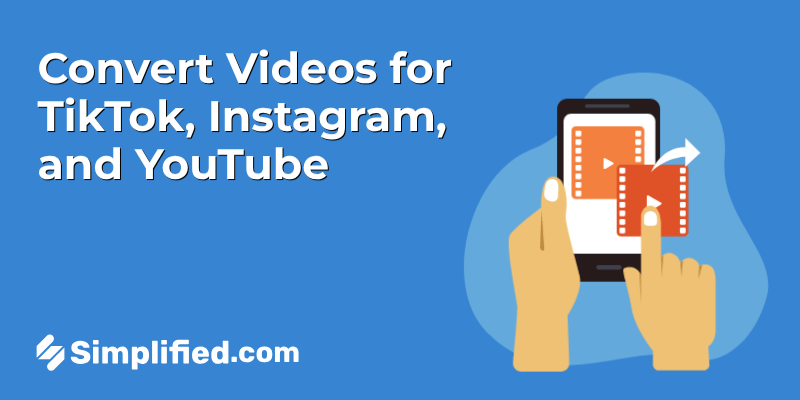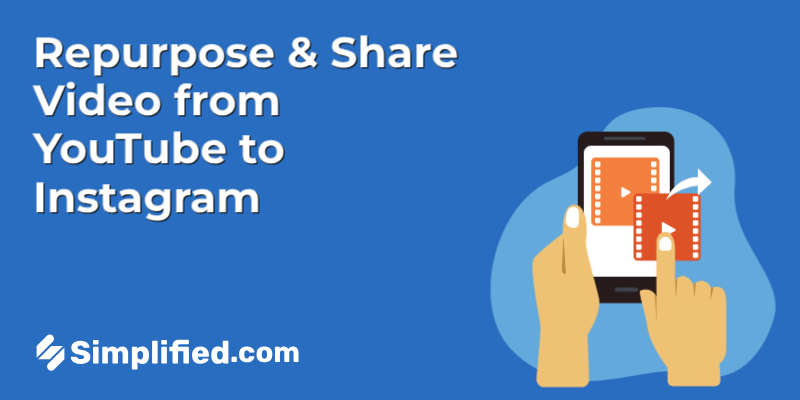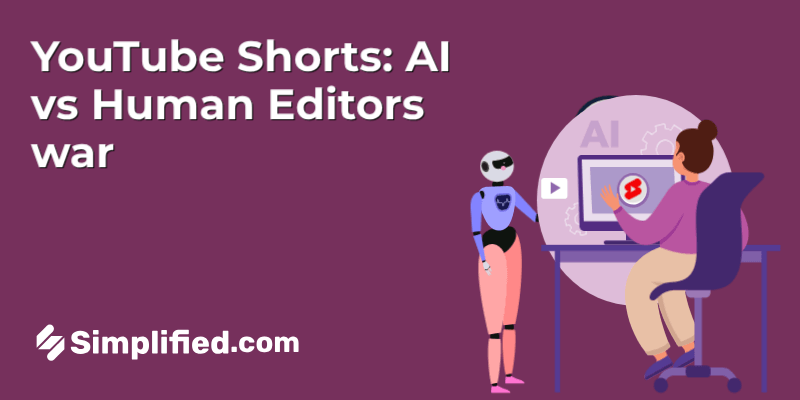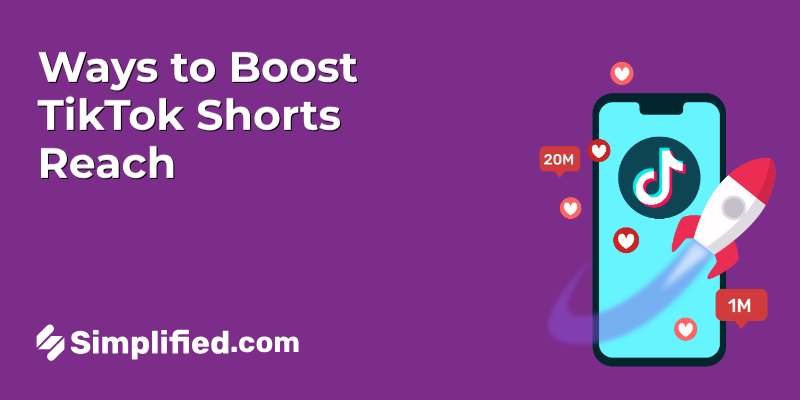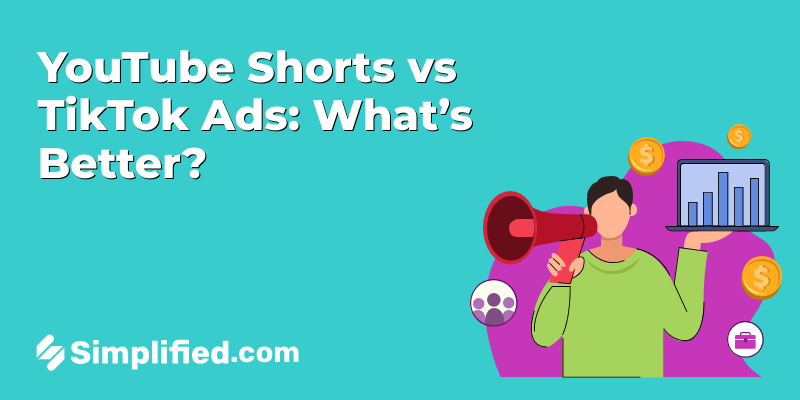
Short-form video content isn’t just a trend—it’s the future of digital marketing. With billions of views daily, YouTube Shorts and TikTok have reshaped how audiences consume and engage with content. Whether it’s quick entertainment, viral challenges, or brand promotions, these platforms dominate the attention economy.
But for businesses and advertisers, the real question isn’t just about popularity—it’s about impact. Which platform offers better reach, engagement, and ROI? TikTok pioneered the short-video revolution, While YouTube Shorts benefits from the massive YouTube ecosystem, each has its own strengths, audience behaviors, and advertising potential.
So, where should your brand invest? YouTube Shorts vs TikTok? In this breakdown, we’ll compare these platforms across key factors, helping you make an informed decision on where to maximize your marketing efforts.
What We’ll Cover:
- User Demographics – Who’s watching and engaging?
- Advertising Formats – What options work best for brands?
- Algorithm & Engagement – Which platform drives more visibility?
- Cost-Effectiveness – Where can you get the most value?
- Creative Flexibility – Which platform allows for better storytelling?
By the end of this YouTube Shorts vs TikTok showdown, you’ll know exactly where to invest your content and budget for maximum impact.
Bonus: How to Turn Long podcast Episodes into YouTube Shorts?
Why Short-Form Video Content is So Popular
Let’s break down why short-form videos have become a hit:
- Shorter Attention Spans: With the fast-paced nature of modern life, people appreciate Short Form Video content that gets to the point quickly.
- Easily Shareable: The concise format makes it easy for users to share videos across other platforms and with their friends.
- High Engagement: Interactive features like comments, shares, and likes are abundant, making it easier to create a community around your content.
Importance of Choosing the Right Platform
When looking at YouTube Shorts vs TikTok, it’s crucial to understand the unique offerings and audience of each platform:
- YouTube Shorts: Using YouTube’s existing vast user base, Shorts offers a built-in audience already familiar with the platform. The ad formats also integrate with other YouTube ads, giving advertisers cohesive campaign opportunities.
- TikTok: Known for its younger demographic, TikTok provides advertisers with innovative ad formats and viral potential due to its unique algorithm. Engaging with this platform can mean tapping into fresh trends and meme culture.
Whether you choose YouTube Shorts ads or TikTok, understanding each platform’s strengths can help maximize your ad spend and reach the most relevant audience.
Understanding Youtube Shorts Ads

As a rapidly growing platform, YouTube Shorts offers immense potential for advertisers looking to engage with a wide and diverse audience. Launched as a direct competitor to TikTok, YouTube Shorts is Google’s entry into the short-form video market, providing unique features for both creators and marketers.
Overview of YouTube Shorts as a Platform
YouTube Shorts is essentially a section of YouTube dedicated to creating and sharing short videos up to 60 seconds in length. It’s accessible both via the YouTube app and the website. This platform is particularly geared towards quick, creative, and impactful content that can go viral rapidly.
Types of Ads Available on YouTube Shorts
- In-Stream Ads: These are brief ads that appear before, during, or after a video. They are either skippable or non-skippable.
- Overlay Ads: Semi-transparent ads appearing at the bottom portion of the video. This ad format is less intrusive and allows users to continue watching as the ad plays.
- Bumper Ads: Non-skippable ads that are only six seconds long, designed for brief and memorable engagements.
- Discovery Ads: These ads appear on the YouTube homepage, search results, and alongside related videos. They entice users to click through to your video content.
Audience Demographics on YouTube Shorts
YouTube Shorts attracts a younger audience, predominantly between the ages of 18-34, similar to TikTok. Interest areas include entertainment, lifestyle, fashion, and technology. However, given the vast reach of YouTube, it also attracts a broader range of users across different age groups and niches.
Advantages of Advertising on YouTube Shorts
- Massive Reach: With billions of users already on YouTube, Shorts taps into this extensive audience base, ensuring your ads reach a broader spectrum of potential customers.
- High Engagement: Short-form videos are designed to be highly engaging and easily consumable, leading to more potential interactions with your ads.
- In-depth Analytics: YouTube offers robust analytics tools to track the performance of your ads, providing insights into viewer behavior and ad effectiveness.
- Integration with YouTube Ecosystem: YouTube Shorts seamlessly integrates with the broader YouTube platform, allowing for cohesive marketing strategies across various content types.
Bonus: Opus Clips vs Pictory vs Simplified: Which Tool is Better For Youtube Shorts?
How to Run Youtube Shorts Ads
Here’s an updated guide to help you easily set up your YouTube Shorts ad campaign:
1. Sign into Your Google Ads Account: Navigate to Google Ads and log in with your credentials.
2. Create a New Campaign: Click on the “Create Campaign” button. Select your campaign objective, such as “Sales” or “Leads”. Choose “Video” as the campaign type.
3. Configure Campaign Settings
- Bidding Strategy: Opt for strategies like Maximize Conversions or Target CPA to align with your goals.
- Budget: Set a daily or total campaign budget that suits your advertising plan.
- Networks: Ensure that “YouTube Shorts” is selected as a placement.
4. Define Your Target Audience
- Demographics: Specify age, gender, parental status, and household income.
- Interests and Behaviors: Target users based on their interests and online activities.
- Devices: Since Shorts are primarily viewed on mobile, consider focusing on mobile devices.
5. Create Your Ad: Add your video to your YouTube channel. Copy the video’s URL and paste it into the ad creation form in Google Ads.
Bonus Tips: Video Requirements:
- Format: Vertical (9:16 aspect ratio).
- Resolution: At least 1080×1920 pixels.
- Length: Up to 60 seconds.
6. Finalize and Launch: Click “Create Campaign” to launch your ad. Now Double-check all configurations, including targeting and budget.
Understanding TikTok Ads
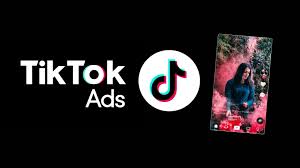
If you’re considering advertising on social media, TikTok should be at the top of your list. Known for its short-form video content and massive user base, TikTok has become a go-to platform for brands aiming to capture audience attention with creative and engaging advertisements. Let’s delve deeper into TikTok as a platform and explore the types of ads available, the audience demographics, and the advantages of advertising on TikTok.
Overview of TikTok as a Platform
TikTok is a social media platform that allows users to create and share short videos, typically set to music. Since its launch, TikTok’s popularity has skyrocketed, particularly among younger demographics. With its user-friendly interface and innovative features, TikTok has become a global sensation for both creators and consumers.
Types of Ads Available on TikTok
There are several types of ads available on TikTok, each designed to fit different marketing goals and budgets:
- In-Feed Ads: These ads appear in the native news feed of TikTok users. They are skippable and usually include a call to action such as a link to a website or app download.
- Branded Hashtag Challenges: These ads encourage users to create content around a specific hashtag, creating a viral trend and enhancing user engagement.
- TopView Ads: These are the first ads users see when they open the TikTok app. They offer maximum visibility and carry significant impact.
- Branded Effects: These ads allow brands to create custom stickers, filters, and effects that users can apply to their own videos, increasing brand visibility organically.
- Brand Takeover: These full-screen ads appear as soon as a user opens the app and can include images, GIFs, or videos with a direct link to a landing page or hashtag challenge.
Audience Demographics on TikTok
Understanding who uses TikTok can help tailor your advertisements more effectively. The platform predominantly attracts younger audiences:
- 41% of TikTok users are between the ages of 16 and 24.
- 56% of users are male and 44% are female.
- TikTok is popular in various regions, with significant usage in countries like the USA, India, and China.
This demographic breakdown makes TikTok a prime platform for brands looking to target young, tech-savvy consumers who are highly engaged and spend considerable time on the app.
Advantages of Advertising on TikTok
Advertising on TikTok offers numerous advantages:
- High Engagement Rates: TikTok users are highly engaged, frequently interacting with content, which translates to higher viewer interaction for ads.
- Viral Potential: The platform’s format encourages the creation and sharing of viral content, which can exponentially increase the reach and impact of your advertisements.
- Creative Freedom: With TikTok’s unique editing tools and features, brands have the creative freedom to produce innovative and captivating ads that resonate with their target audience.
- Cost-Effective Options: TikTok offers a variety of ad types to suit different budgets, making it accessible for brands of all sizes.
- Enhanced Targeting: The platform provides robust targeting options, allowing advertisers to reach specific demographics, interests, and behaviors effectively.
In conclusion, TikTok offers a vibrant platform for advertisers to engage a young, active audience. With diverse ad formats like in-feed ads and hashtag challenges, brands can expand their reach and achieve their marketing goals.
Bonus: Meta Ad Library: An In-Depth Look Into The Facebook Ad Library
YouTube Shorts vs TikTok: Comparing Ad Performance
When deciding between YouTube Shorts and TikTok for advertising, it’s essential to consider engagement, cost, and targeting capabilities to determine which platform aligns with your goals.
Engagement Rates
TikTok often sees higher engagement due to its interactive features and viral content. While YouTube Shorts benefits from YouTube’s established audience, it generally experiences lower engagement numbers compared to TikTok.
Ad Costs
TikTok offers lower CPM and CPC, making it more cost-effective for brands with smaller budgets. YouTube Shorts, however, can provide better long-term ROI through YouTube’s monetization options and broader audience targeting.
Targeting Capabilities
TikTok provides strong targeting based on user interests and behaviors. YouTube Shorts, backed by Google’s powerful data analytics, allows for more precise targeting using search habits and user engagement.
User Feedback & Brand Impact
TikTok provides quick insights into user engagement and reactions, while YouTube Shorts offers in-depth brand lift metrics, helping brands understand long-term effects on awareness and consumer perceptions.
Bonus: 13 Best Opus Clip Alternatives
YouTube Shorts vs TikTok Ads: Ad Formats and Targeting Compared
In the battle of Youtube Shorts vs Tiktok Ads, understanding the ad formats and targeting options plays a crucial role in deciding where to allocate your advertising budget. Let’s compare the ad formats available on both platforms, analyze the targeting options they provide, and discuss the pricing models and budget considerations for advertising on Youtube Shorts and Tiktok.
Ad Formats Comparison
Youtube Shorts:
- Skippable In-Stream Ads: Viewers can skip these ads after 5 seconds.
- Non-Skippable In-Stream Ads: Short ads that play before or during the video and can’t be skipped.
- Video Discovery Ads: Promote videos that appear in YouTube search results and related video sections.
- Overlay Ads: Semi-transparent overlay ads that appear on the bottom part of the video.
Tiktok:
- In-Feed Ads: Ads that appear in between user-generated content in the “For You” feed.TopView Ads: Take over the screen when the app is first opened, guaranteeing a full-screen immersive ad experience.
- Branded Hashtag Challenges: Engage users by inviting them to participate in trending challenges, creating UGC that furthers brand reach.
- Branded Effects: Custom AR effects, filters, and stickers that users can interact with in their videos.
Targeting Options Overview
Youtube Shorts:
- Demographics: Target by age, gender, parental status, and household income.
- Interests: Reach audiences based on their interests and habits.
- Custom Intent: Target users based on specific keywords they are actively searching.Life Events: Engage with users during major life events like marriage, graduation, etc.
- Behavioral Targeting: Advertise based on users’ past behavior and interactions with content.
Tiktok:
- Demographics: Age, gender, and location targeting.
- Interests: Target based on user interests and activity.
- Behavioral: Focus on users’ behavior on the app.
- Device: Target users based on the device they use.
- Custom Audiences: Reach out to users who have previously interacted with your ad elsewhere.
Pricing Models and Budget Considerations
Youtube Shorts:
- Cost-Per-View (CPV): Pay for ad views and interactions like clicks and calls.
- Cost-Per-Thousand-Impressions (CPM): Pay for every thousand views of the ad.
- Cost-Per-Click (CPC): Pay each time a user clicks on the ad.
Tiktok:
- Cost-Per-Thousand-Impressions (CPM): This aligns most closely with the standard ad pricing model.
- Cost-Per-Click (CPC): Pay each time a user clicks on the ad.
- Cost-Per-Mille (CPM) for Brand Takeovers: A unique model for ads that appear as soon as users open the app.
- Biddable Ads: Allows bidding for various objectives like clicks, installs, and engagement.
Ultimately, making an informed decision between Youtube Shorts ads or Tiktok will depend on your specific marketing goals, target audience, and budget flexibility. Both platforms offer robust options for ad formats and targeting, but the best choice will depend on where you think your audience will engage more effectively with your ads.
Bonus: How to Create Viral YouTube Shorts: Tips from Top Creators
Content Creation Differences
Creating content for YouTube Shorts ads vs TikTok ads requires understanding each platform’s unique creative guidelines. These differences can affect how users engage with your ads and influence campaign success.
YouTube Shorts Ads
YouTube Shorts focuses on quick, engaging videos that seamlessly integrate into the YouTube ecosystem. Content should be mobile-optimized, visually appealing, and aligned with YouTube’s diverse audience interests.
TikTok Ads
TikTok thrives on organic, fun, and trend-driven content. Ads should feel native to the platform, often featuring user-generated content and incorporating viral challenges or music to capture attention.
Creative Guidelines for Youtube Shorts Ads
Youtube Shorts offers a dynamic way to reach audiences with short, engaging videos. To create high-performing Youtube Shorts ads, follow these creative guidelines:
- Keep it short and sweet: Aim for videos that are 15-60 seconds long to maintain viewer interest.
- Start with a hook: Capture attention within the first few seconds to prevent users from scrolling away.
- High-quality visuals: Utilize clear, vibrant visuals and avoid overly complex scenes.
- Mobile-friendly: Remember that most users will view your content on mobile devices, so design accordingly.
- Incorporate music and effects: Use trending music tracks and creative effects to enhance the user experience.
Creative Guidelines for TikTok Ads
TikTok is known for its highly engaging and interactive content. Here are key creative guidelines for creating TikTok ads:
- Engage immediately: Similar to Youtube Shorts, ensure your ad grabs attention in the first 2-3 seconds.
- Authentic content: Prefer raw and authentic content over highly polished videos to resonate with the TikTok community.
- Use popular trends: Utilize trending hashtags, challenges, and music to increase visibility.
- Encourage interaction: Create content that encourages users to comment, share, or participate in challenges.
- Storytelling: Craft a compelling story that connects with your audience emotionally.
User Behavior and Content Preferences
Understanding user behavior and content preferences is crucial for success on both Youtube Shorts and TikTok.
- Youtube Shorts: Users typically expect quick, informative, or entertaining content. They tend to focus on visual and audio quality, as well as the relevance of the content.
- TikTok: Users look for authentic and creative content that feels organic and engaging. Trends and challenges play a significant role in user preference, and content that encourages interaction tends to perform well.
Ultimately, adapting your content creation strategy to the unique characteristics of Youtube Shorts and TikTok will help you better connect with your audience and drive more effective advertising campaigns.
Picking the Best Platform for Advertising Results
When deciding between Youtube Shorts vs Tiktok Ads for your marketing campaigns, selecting the right platform is crucial. A well-chosen platform can amplify your outreach, engagement, and conversion rates, propelling your business towards its goals. Here are key tips to help you make an informed decision:
Aligning Platform Choice with Business Goals
Begin by clarifying your business objectives. Whether you aim to generate brand awareness, drive traffic, or increase sales, your platform choice should support these goals. For instance:
- Brand Awareness: If your goal is to reach a wide audience quickly, Tiktok’s viral and shareable content format might better serve your needs.
- Traffic and Conversions: If you seek to drive users to your website or increase conversions, Youtube Shorts ads with its integration into the larger YouTube ecosystem might offer a more seamless transition from viewing to action.
Considering Your Target Audience and Where They Spend Time
Understanding your audience demographics and behavior is critical. Consider these factors:
- Demographics: While both platforms cater to younger audiences, the specific demographics can vary. Research and assess where your target age group spends most of their time.
- Engagement: Analyze engagement rates on both platforms. Tiktok is known for its highly interactive user base, while YouTube might offer deeper content engagement.
Analyzing Competitor Performance on Both Platforms
Take a look at what your competitors are doing. Monitor their ad performance on both Youtube Shorts and Tiktok. This will give you insights into what works and what doesn’t:
- Content Strategies: Study the type of content they post, their frequency, and user responses.
- Ad Effectiveness: Use tools like social media analytics to gauge the effectiveness of their ads based on views, likes, shares, and comments.
Testing and Optimizing Ad Campaigns on Both Platforms
The best way to determine the right platform is through testing and optimization. Implement the following approach:
- Split Testing: Create similar ad campaigns for both Youtube Shorts and Tiktok. Compare the performance metrics like reach, engagement, and conversion to assess which platform offers better ROI.
- Continuous Improvement: Use the data and insights gained from your tests to optimize your campaigns. Adjust targeting, content, and spending based on performance analytics.
In conclusion, carefully aligning your platform choice with business objectives, understanding your audience, analyzing competitor performance, and rigorously testing your campaigns will help you make a strategic decision between Tiktok vs Youtube Shorts Ads.
Final Thoughts: Choosing Between YouTube Shorts and TikTok Ads
In this blog, we’ve explored the comparative benefits of YouTube Shorts vs TikTok Ads, each offering unique strengths for advertisers. Here’s a summary of the key takeaways:
- Audience Reach: TikTok has a predominantly younger user base, while YouTube Shorts attracts a more diverse age range.
- Content Style: TikTok is known for its virality and trend-focused content, whereas YouTube Shorts emphasizes more on informational and tutorial-style videos.
- Engagement Metrics: Both platforms offer robust analytics, but the type of engagement—comments, shares, and likes—varies slightly between the two.
- Ad Types and Formats: YouTube Shorts Ads integrate smoothly into the YouTube ecosystem, offering more traditional video ad functionality. TikTok Ads, however, are more innovative with interactive elements like hashtag challenges.
- Cost and ROI: While both platforms offer competitive pricing models, the return on investment largely depends on your specific campaign goals and the type of content you produce.
When deciding where to allocate your advertising budget between YouTube Shorts Ads and TikTok Ads, consider the following recommendations:
- Business Goals: Define clear objectives. For brand awareness among Gen Z, TikTok could be highly effective. For driving traffic and generating leads across multiple demographics, YouTube Shorts might be the better option.
- Target Audience: Analyze your audience demographics. If your target audience is predominantly teenagers and young adults, TikTok is a solid choice. For a broader age group, including millennials and older adults, YouTube Shorts would be more suitable.
- Content Creation Capability: Assess what kind of content you excel at creating. TikTok favors quick, trendy, and highly engaging ai clips. If your forte is creating more detailed or informative videos, YouTube Shorts will likely yield better results.
Ultimately, both platforms offer incredible opportunities for brands willing to tailor their content to each unique audience. Align your strategy with your goals, know your audience, and make data-driven decisions to maximize the effectiveness of your marketing campaigns.


